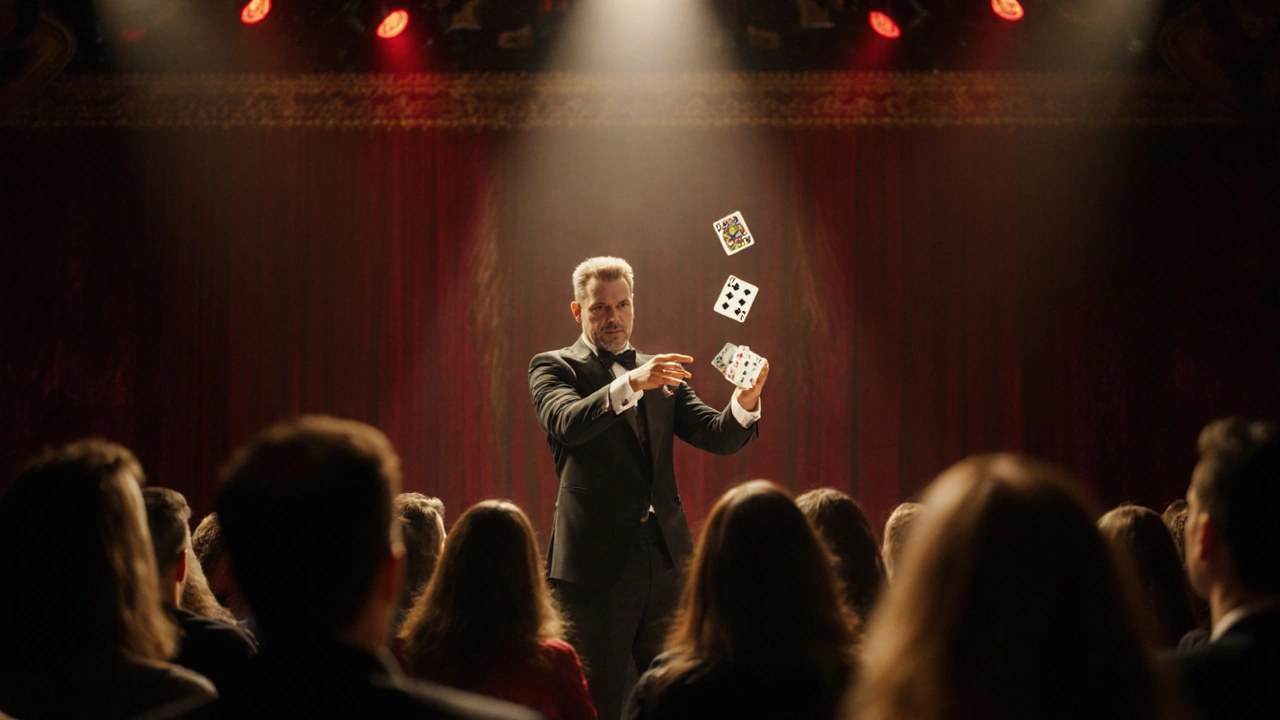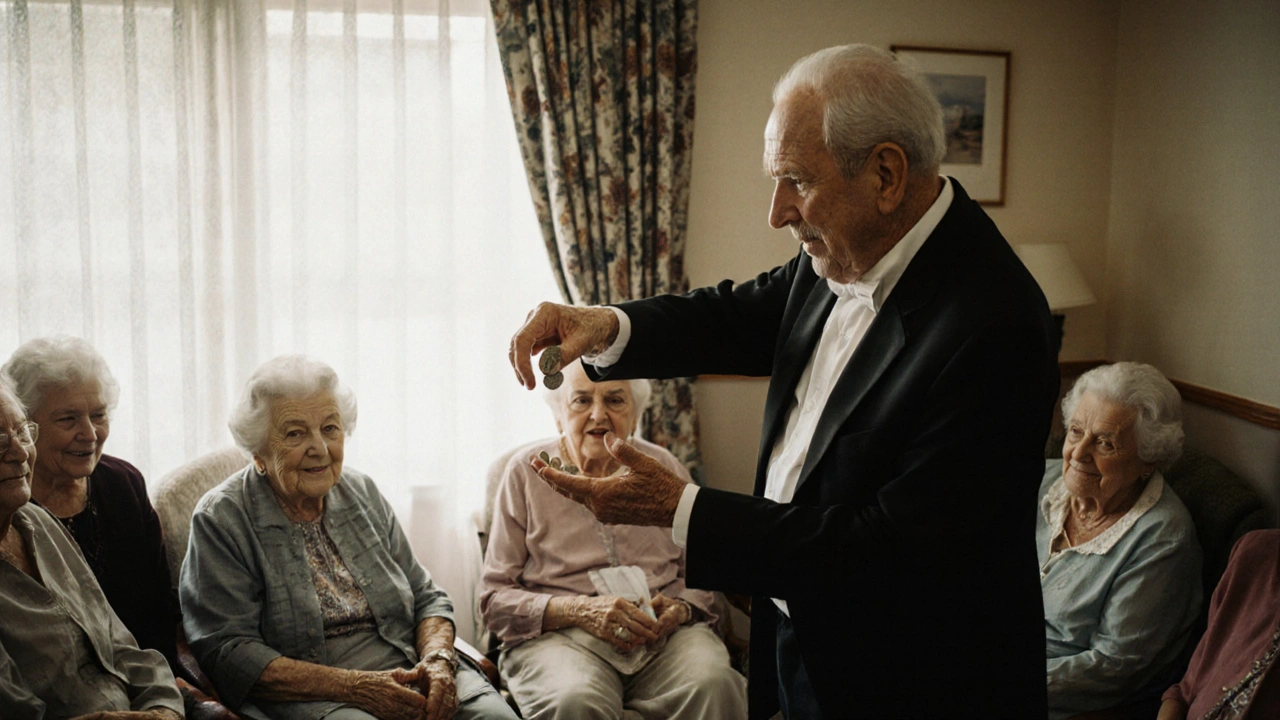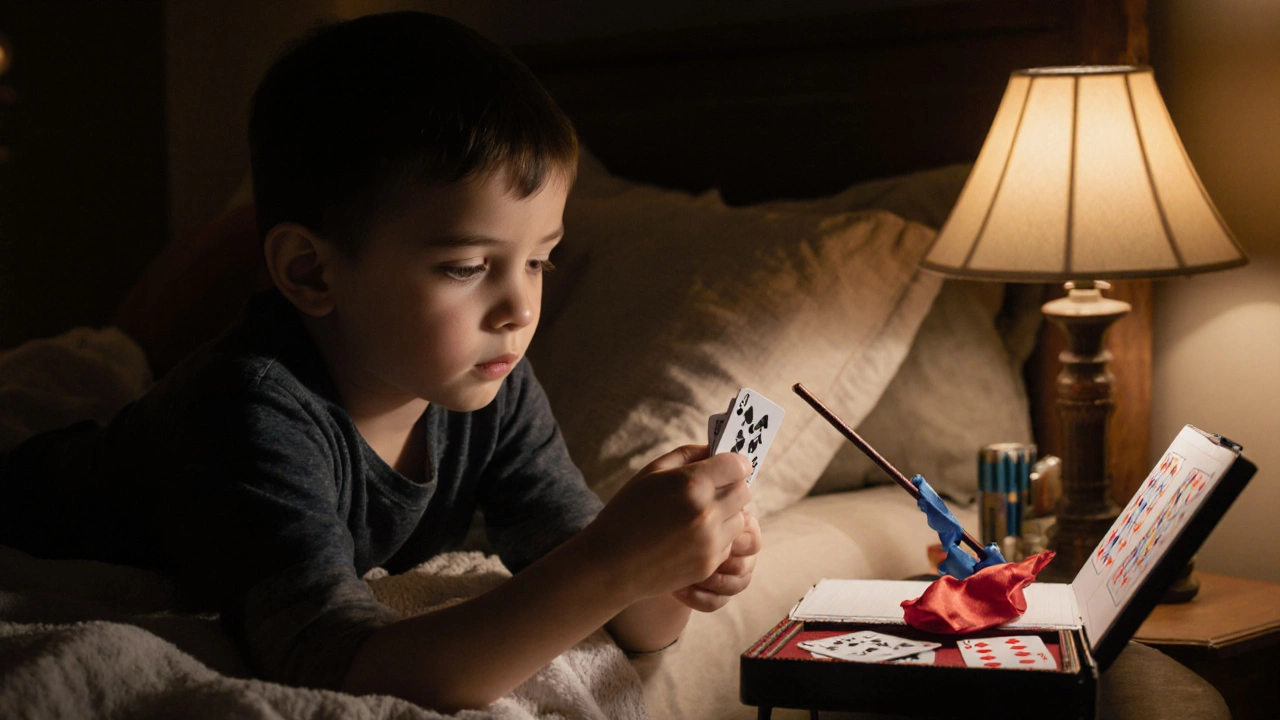Most people think magic tricks are just about pulling a rabbit out of a hat or making a coin disappear at a birthday party. But the real story behind magic is deeper-it’s about control, psychology, and years of practice. What starts as a silly trick with a deck of cards can become a full-time career, performed on Broadway or in Las Vegas theaters. The line between a kid showing off a trick to friends and a professional magician commanding a sold-out crowd isn’t wide-it’s built one small skill at a time.
The Roots of Magic: How It All Begins
Every professional magician started somewhere. For most, it was a Christmas gift-a cheap magic kit with a wand, a silk scarf, and a few basic card tricks. These kits aren’t just toys. They’re the first step into a world where misdirection, timing, and showmanship matter more than the trick itself. A 10-year-old learning to palm a coin isn’t just practicing a move; they’re learning how to control attention. That’s the real magic.
Studies from the University of London show that people’s brains literally miss details when their focus is pulled elsewhere. Magicians exploit this. A simple trick like the three-card monte works because your eyes follow the wrong hand. The card you think is under the middle one? It never moved. Your brain filled in the gap. That’s not luck-it’s neuroscience.
From Living Room to Stage: The Transition
Moving from party tricks to professional performances isn’t about doing more complex tricks. It’s about changing how you present them. A kid might show off a trick by saying, “Watch this!” A pro says, “I once met a woman who could read minds… and I’m going to prove it to you tonight.” The difference? Storytelling.
Professional magicians don’t just perform tricks-they build experiences. David Blaine didn’t become famous because he could balance a coin on his forehead. He did it because he turned a simple act into a 72-hour endurance challenge on a street corner in New York. Penn & Teller turned magic into theater, using humor, irony, and even exposing how tricks work to make audiences think harder.
The best magicians know this: the audience doesn’t care how the trick works. They care how it made them feel. A well-timed pause. A raised eyebrow. A quiet whisper. These are the tools that turn a simple sleight of hand into something unforgettable.
The Tools of the Trade: More Than Just Cards
Yes, playing cards are the most common tool. But professional magicians use far more. A classic trick like the “Ambitious Card”-where a selected card keeps rising to the top of the deck-requires perfect finger control. That’s called sleight of hand, and it takes hundreds of hours to master. But it’s not just about dexterity. It’s about rhythm. A bad magician rushes. A good one lets the audience breathe.
Other tools include:
- Props like silk handkerchiefs, coins, ropes, and balls
- Specialized decks with hidden markings or gimmicked cards
- Mirrors, magnets, and hidden compartments for larger illusions
- Lighting and sound design to guide focus
Some magicians even use technology. Modern illusions sometimes involve projectors, LED screens, or motion sensors. But the best ones still rely on the oldest trick: human perception. No app can replace the shock on someone’s face when they realize the impossible just happened right in front of them.

The Psychology Behind the Illusion
Magic isn’t about hiding things-it’s about making people believe what isn’t there. A magician doesn’t need to hide the card. They just need to make you forget you ever looked for it. That’s called cognitive misdirection. It’s why a magician will ask you a question right before the trick. Your brain is busy answering, not watching.
Research from the University of Cambridge shows that even when people know a trick is fake, they still feel wonder. That’s because magic triggers the same part of the brain that responds to art, music, or awe-inspiring nature. It’s not about deception-it’s about wonder.
That’s why the best magicians avoid saying, “I’m going to make this disappear.” Instead, they say, “Something strange is about to happen.” They don’t set expectations-they create mystery.
Learning to Perform: What No Magic Kit Teaches You
Most magic books and YouTube tutorials focus on moves. But performance? That’s learned the hard way-on stage, in front of real people. Here’s what no beginner’s guide tells you:
- Don’t over-explain. If you say too much, you give away the secret.
- Practice in front of mirrors, then in front of pets, then in front of friends. Each step reveals new flaws.
- Record yourself. You’ll be shocked at how nervous you look-even if you feel calm.
- Learn to handle mistakes. If you drop a card, smile. Laugh. Keep going. The audience will forget the error if you stay confident.
- Know your crowd. A trick that works at a birthday party might fall flat at a corporate event.
One magician in Chicago started performing at nursing homes. He learned to read silence. He learned that a slow, deliberate movement meant more than a flashy flourish. That’s where he found his style-and his audience.

What Makes a Professional Magician?
There’s no official license. No certification. But you can spot a pro in five seconds:
- They don’t rush. Every move has purpose.
- They make eye contact-not with the trick, but with the person watching.
- They never say, “This is impossible.” They let the audience say it.
- They’ve performed the same trick 100 times, but act like it’s the first.
- They’ve been booed, ignored, and forgotten-and kept going.
The most successful magicians aren’t the ones with the biggest illusions. They’re the ones who understand people. They know when to pause. When to smile. When to stay quiet.
Where Magic Goes Next
Magic isn’t dying. It’s evolving. TikTok has given rise to a new generation of street magicians who perform for cameras instead of crowds. Virtual reality magic shows are starting to appear. But the core hasn’t changed. People still want to believe in the impossible.
Young magicians today are blending magic with comedy, dance, and even AI. One performer in Portland uses facial recognition software to make a card appear in someone’s phone-based on their expression. It’s not magic anymore. It’s something stranger: a conversation between human emotion and technology.
But the best magic still happens in small rooms, with one person holding their breath, wondering how it was done. And that’s okay. Because magic doesn’t need a stage. It just needs someone willing to look-and believe.
Can anyone learn magic tricks, or do you need special talent?
Anyone can learn magic tricks. Talent helps, but it’s not required. What matters most is patience and repetition. A simple card trick might take 20 hours to master. That’s not because it’s hard-it’s because your hands need to remember the move before your brain does. Most professional magicians started with no natural ability. They just kept practicing.
Are magic tricks based on science or just deception?
Magic is built on science-especially psychology and perception. Tricks rely on how the brain processes information, where attention goes, and what it ignores. A card trick isn’t magic because it’s supernatural. It’s magic because your brain gets tricked into seeing something that didn’t happen. The science behind it is well-documented, but the effect still feels real.
How long does it take to become a professional magician?
There’s no set timeline, but most professionals spend at least 3-5 years practicing before they get paid gigs. The first year is about learning moves. The second is about fixing bad habits. The third is about performing in front of real people. The fourth is about building confidence. The fifth? That’s when you start to find your voice. Some take longer. Some faster. But no one skips the work.
Is it better to start with cards or props like coins and ropes?
Start with cards. They’re cheap, portable, and give you immediate feedback. You can practice them anywhere-even on a bus. Cards teach you control, timing, and misdirection. Once you’ve mastered basic card moves, moving to coins or ropes becomes easier. Coins are harder because they’re smaller and require finer finger control. Ropes need more space and are harder to hide. Cards are the foundation.
Do magicians ever reveal how tricks work?
Most magicians won’t reveal secrets to the public-it breaks the illusion. But many share how tricks work with other magicians. That’s part of the community. Some, like Penn & Teller, reveal methods on purpose to show how easy it is to fool people. It’s not about giving away secrets-it’s about teaching people to question what they see. Either way, the real magic isn’t in the method. It’s in the moment.


Janiss McCamish
November 20, 2025 AT 14:19My little sister got a magic kit for Christmas and now she’s obsessed. She practices in the mirror every night. I didn’t think much of it until she made my coffee cup disappear during breakfast. I still haven’t figured it out. She’s only 11.
Richard H
November 21, 2025 AT 01:26USA invented real magic. All these fancy tricks overseas are just copies. Real magic is about grit, not gimmicks. You want to see real skill? Watch a guy make a card vanish in a bar in Chicago-no lights, no screens, just pure American hustle.
Kendall Storey
November 22, 2025 AT 14:14Bro, the real magic isn’t the sleight-it’s the misdirection. Cognitive load, attentional blink, predictive coding-all of it’s baked into every trick. You think the card’s under the middle one? Nah. Your prefrontal cortex is busy processing the magician’s smirk. That’s the art. That’s the science. That’s the whole damn game.
Ashton Strong
November 22, 2025 AT 18:31It is truly inspiring to observe how dedication, discipline, and an unwavering commitment to craft can transform an innocent childhood pastime into a profound art form. The psychological depth and emotional resonance of professional magic are nothing short of extraordinary.
Steven Hanton
November 24, 2025 AT 15:43I’ve been practicing card tricks for two years now. I started with the basic pass and now I can do a double lift without thinking. But the hardest part? Not the move-it’s learning when to stop talking. I used to explain everything. Now I just smile and wait. The silence is the trick.
Pamela Tanner
November 26, 2025 AT 13:31Every sentence in this post is impeccably constructed. The transition from child’s play to cognitive neuroscience is seamless. The use of empirical research to ground magical practice elevates this from entertainment to academic inquiry. Well done.
Kristina Kalolo
November 28, 2025 AT 01:23I’ve seen magicians on TV and thought it was all smoke and mirrors. But reading this, I realize it’s more like a dance between the performer and the observer’s mind. I still don’t know how they do it-but now I’m curious how they think.
ravi kumar
November 28, 2025 AT 12:08In India, we have a tradition called 'Pandit Jadoo'-old men in saris pulling coins from your ear. No props, no stage. Just hands and eyes. Same principle. Magic is universal. It’s not about the trick-it’s about the pause before the reveal.
Megan Blakeman
November 29, 2025 AT 18:59I just cried a little reading this… like, seriously… magic isn’t about tricks… it’s about wonder… and we’ve forgotten how to feel wonder… I want to learn… I want to make someone feel that…
Akhil Bellam
November 29, 2025 AT 22:23Pathetic. You call this depth? Any half-wit with a YouTube channel and a cheap deck can spout neuroscience buzzwords. Real magic? It’s in the silence between breaths. It’s in the sweat on the palms of a man who’s practiced the same move for 12,000 hours-while you were scrolling. You’re not a magician-you’re a content consumer.
Amber Swartz
November 30, 2025 AT 01:41Okay but like… what if the magician is actually a ghost? What if the card never moved because the audience is already dead? What if the whole thing is a metaphor for capitalism? I just need to know… I can’t sleep…
Robert Byrne
November 30, 2025 AT 21:53You said 'misdirection' but you misspelled it as 'misdirection' in the third paragraph. It's 'misdirection.' Also, 'sleight of hand' is correct, not 'slight.' Fix your grammar. Magic deserves precision.
Tia Muzdalifah
December 2, 2025 AT 17:29my bff from indonesian family taught me this trick with a napkin and a coin-no words, just eyes. i still do it at family dinners. they all gasp. it’s not about the move. it’s about the look you give them right before. that’s the magic.
LeVar Trotter
December 3, 2025 AT 16:16The real power move? Using lighting to control where attention lands. That’s not just stagecraft-that’s neuro-engineering. LED arrays synced to heartbeat rhythms? That’s next-gen misdirection. The future of magic isn’t in cards-it’s in synchronized sensory manipulation.
Tyler Durden
December 4, 2025 AT 15:17Wait-so you’re telling me I’ve been wasting my life on TikTok dances when I could’ve been mastering the palm? I’m quitting my job. I’m buying a deck. I’m sleeping with my cards. I’m gonna make my dog disappear. And then I’m gonna cry when it comes back. This changed everything.